Why Equine Therapy is Coming To Be a Preferred Alternative for Emotional Health
Why Equine Therapy is Coming To Be a Preferred Alternative for Emotional Health
Blog Article
Reviewing the Performance of Laser Treatment in Horse Treatment for Injury Rehab
The assessment of laser treatment's efficiency in equine injury recovery depends upon numerous factors, consisting of healing time, pain mitigation, and tissue regeneration. Medical studies recommend noteworthy improvements in problems like tendonitis and osteo arthritis, connected to boosted cellular feature and elevated ATP production. Vets often observe exceptional end results with laser therapy compared to conventional approaches, positioning it as a critical aspect in equine treatment. The requirement for continuous surveillance and personalized therapy strategies can not be overemphasized. What specific scientific proof sustains these cases, and just how do vets implement these methods in practice?
Comprehending Laser Treatment
Laser therapy has actually become a crucial device in veterinary medication, specifically in the treatment of equine conditions. Recognized for its non-invasive nature and efficacy, laser therapy includes the application of particular wavelengths of light to boost cells repair and lower inflammation. This healing technique is significantly favored for its capacity to accelerate the healing process in horses dealing with a range of musculoskeletal injuries and chronic problems.
The primary system behind laser treatment is its capability to enhance mobile functions. When laser light penetrates the skin, it is absorbed by mitochondria, the giant of cells, which brings about raised manufacturing of adenosine triphosphate (ATP) This biochemical energy boost assists in cellular repair service and regrowth. Additionally, laser treatment advertises vasodilation, boosting blood circulation and oxygen shipment to damaged cells, hence expediting recuperation.
In equine medicine, laser treatment is especially advantageous for problems such as tendonitis, osteoarthritis, and injury healing. The strategy is lauded for its pain-relieving homes, permitting equines to restore flexibility and function a lot more rapidly. Vets additionally appreciate its marginal negative effects compared to other therapy modalities, making it a reliable and secure option for equine care.

Just How Laser Treatment Functions

Upon absorption, these photons trigger a collection of biochemical modifications, improving mitochondrial function and bring about boosted adenosine triphosphate (ATP) production. This rise in ATP increases cellular metabolism, advertising tissue repair and regrowth. Furthermore, laser treatment regulates inflammatory reactions by influencing cytokine levels and reducing oxidative stress and anxiety, consequently minimizing pain and swelling.
An additional considerable facet of laser treatment is its role in improving microcirculation. The therapy advertises vasodilation, improving blood circulation and oxygen delivery to broken tissues (Equine Therapy). This assists in the removal of mobile particles and supports the spreading of fibroblasts and collagen synthesis, important for injury healing
Professional Evidence
The efficiency of laser therapy in equine therapy has actually been validated via various scientific researches, showcasing its restorative potential throughout a series of problems. A number of controlled trials and observational studies have actually documented significant improvements in cells repair, pain continue reading this decrease, and total recovery timelines. As an example, a research study performed by Turner et al. (2012) demonstrated that steeds treated with low-level laser treatment (LLLT) for tendon injuries displayed increased recovery compared to those receiving traditional therapies. The research highlighted a marked reduction in inflammation and enhanced collagen formation.
In a similar way, study by Johnson and coworkers (2015) concentrated on equine muscle mass injuries, exposing that laser therapy dramatically quickened muscular tissue fiber regrowth and minimized muscle mass tightness. These findings were substantiated by histological analyses revealing enhanced muscle tissue company. In addition, scientific evaluations have shown that laser treatment can relieve persistent conditions such as osteo arthritis. A research study by Smith et al. (2018) reported that horses with osteoarthritic joints experienced remarkable discomfort relief and raised variety of motion adhering to a program of laser therapy sessions.
Vet Insights

Veterinarians additionally appreciate the flexibility of laser treatment. It can be utilized for a variety of problems, from superficial wounds to much deeper musculoskeletal injuries. Dr. Emily Brown highlights its energy in treating conditions like tendonitis and osteoarthritis, where standard therapies often fail. She mentions that laser therapy can be tailored to the specific needs of each horse, More Help making sure optimum results.
Moreover, veterinarians value the capacity to incorporate laser therapy with various other therapy methods. This multimodal technique can improve overall therapy effectiveness, offering a thorough option for equine rehabilitation. Such recommendations from skilled experts underscore the expanding approval and application of laser therapy in equine medicine.
Practical Considerations
A vital aspect of implementing laser therapy in equine therapy involves comprehending the practical considerations that guarantee its efficiency and safety. Most importantly, it is vital to select the appropriate laser gadget, as numerous types vary in wavelength, power, and penetration deepness. Equine Therapy. Veterinarians must be skilled in these criteria to customize therapy protocols successfully per injury kind
Moreover, the regularity and period of laser treatment sessions need careful preparation to make the most of therapeutic advantages while lessening any prospective unfavorable impacts. Constant surveillance of the equine's feedback to treatment can direct necessary modifications in the treatment program. Establishing a secure and regulated setting during therapies is also vital to stop unintentional exposure to laser emissions, which could damage both the horse and the trainer.
Training and accreditation of workers carrying out laser treatment are paramount to guarantee proper method and to maintain safety requirements. In addition, maintaining exact documents of each session, including laser settings and observed end results, is important for reviewing the overall efficiency of the treatment and for making data-driven choices.
Verdict
Laser therapy has actually emerged as a reliable technique in equine injury rehab, offering significant benefits in recovery time, discomfort relief, and cells healing. For optimum results, continual tracking and individualized therapy protocols continue to be vital in leveraging the full capacity of laser therapy in equine treatment.
Report this page